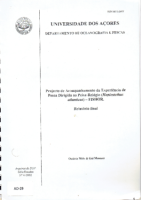Projecto de Acompanhamento da Experiencia de Pesca Dirigida ao Peixe-Relogio (Hoplostethus atlanticus) - FISHOR. Arquivos do DOP, Serie Estudos n° 4/2002

The objective of this project is to monitor the fishing experience of the peixe-relogio (Hoplostethus atlanticus) carried out by S. Macario in order to investigate the existence of unexplored stocks of this and other deep-sea species in the EEZ of Azores. Likewise, to establish whether these species can be exploited in a sustainable way, with a minimum of impact, in the fishing currently carried out in the Region and in its marine environment.
This fishing experience took place in two periods: the first between 10 April and 24 June 2001 and the second between 4 December 2001 and 31 January 2002 on board of the "Pakura" fishing vessel from Nova Zealand. During these periods, 246 fishing trips were carried out between 50 and 200 miles from the Azores EEZ, with a total catch of some 373 tonnes of fish. Of these catches, catches of peixe-relogio (Hoplostethus atlanticus) reached 92% of the total catch by weight of about 343 tonnes and catches of the main accessory species black scabbardfish (Aphanopus carbo) which accounted for 4% of the total catch by weight. On the other hand, during this phase 95 different species of fish are captured: 73 teleosteos, 19 elasmobranchs and 3 holocephalos, belonging to 45 families. It should be noted that about 30 of these species are given for the first time to the Azores. Likewise, some mollusks and crustaceans were also captured. Most of the catches of the peixe-relogio, were obtained at "Banco Sedlo", north of the island of Terceira.
Catches of the peixe-relogio occurred mainly at a depth between 1000 and 1200 m and at a temperature between 5 ° C and 7 ° C. In relation to the yields obtained for the peixe-relogio, a CPUE spectrum by weight of 0.0-4455 kg / min of effective trawling was observed. During the experiment, 8113 individuals were measured and 2778 individuals were weighed individually, with a biological sample of 3141 individuals. The female of peixe-relogio have a mean value of standard length and weight greater than the male, being able to reach 60 cm of standard length and 8 kg of weight. The time of reproduction of the peixe-relogio in the Azores occurs in winter and the length of 1st calculated maturation was 30cm.
At this moment studies are still taking place, on growth, although it is starting in the DOP, it is still waiting for the establishment of a partner with another Institution. On the other hand, it was not possible from the data obtained to evaluate the distribution and the actual abundance of the resource in the Azores EEZ. In this way, the development of this fishery will always have to be preceded by more research (acoustic and surface area cruises) and the coverage of a larger survey area. Likewise, it will also be important to maintain a precautionary approach until the ecological and biological aspects of the species are known in greater detail, while maintaining the conditions set out in the Code of Conduct, should the experience develop in the future.







